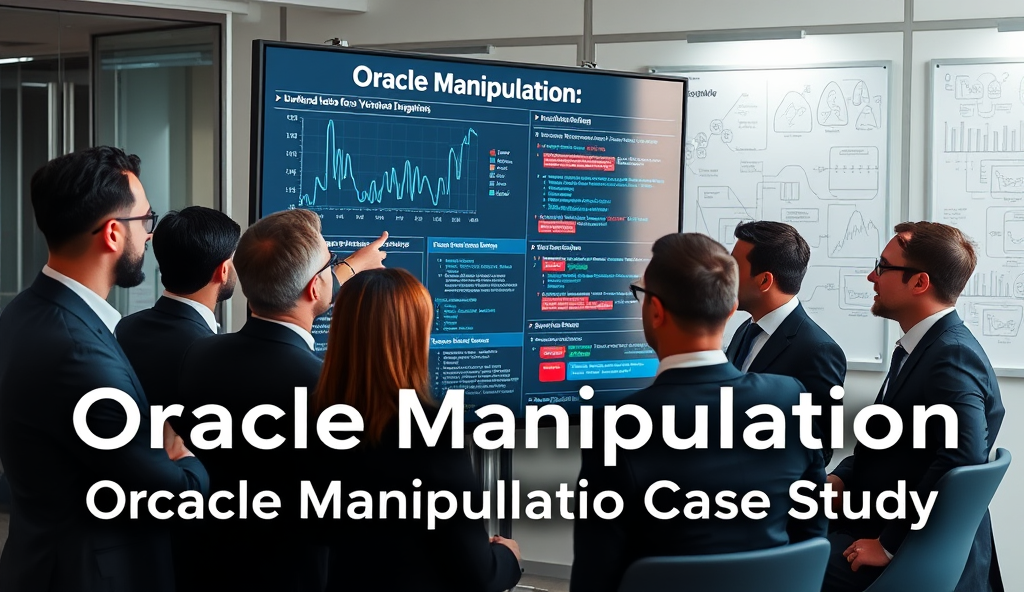Introduction to Oracle Manipulation in Smart Contracts
Oracle manipulation attacks occur when bad actors exploit vulnerabilities in price feeds or data sources that smart contracts rely on, leading to inaccurate executions. The 2020 Harvest Finance incident, where attackers manipulated oracle price feeds to drain $34 million, demonstrates the severe financial impact of these exploits.
Such attacks typically target DeFi protocols that depend on single oracle sources without proper validation mechanisms.
Blockchain oracle vulnerabilities analysis reveals that manipulation often happens through flash loans or market price distortions during low-liquidity periods. For example, the 2021 PancakeBunny exploit involved artificially inflating token prices through manipulated oracle data before liquidating positions.
These incidents highlight the need for robust oracle security measures in smart contract development.
Understanding these manipulation techniques is crucial for developers building secure decentralized applications. The next section will explore how oracles function within blockchain ecosystems and why their role makes them prime targets for exploitation.
Key Statistics

Understanding Oracles and Their Role in Blockchain
Oracle manipulation attacks occur when bad actors exploit vulnerabilities in price feeds or data sources that smart contracts rely on leading to inaccurate executions.
Blockchain oracles act as bridges between smart contracts and external data sources, enabling decentralized applications to interact with real-world information like price feeds or weather data. Their critical role in executing contract logic makes them vulnerable targets, as seen in the Harvest Finance and PancakeBunny exploits discussed earlier.
Oracles can be centralized (single data source) or decentralized (multiple sources with consensus), with the latter offering better resistance to manipulation. However, even decentralized systems face risks if not properly designed, particularly when relying on low-liquidity markets or untrusted data providers.
Understanding these foundational mechanics helps explain why oracle manipulation attacks are so impactful, setting the stage for examining specific attack vectors in the next section. The security of entire DeFi ecosystems often hinges on oracle reliability, making their design a top priority for developers.
Common Types of Oracle Manipulation Attacks
Blockchain oracles act as bridges between smart contracts and external data sources enabling decentralized applications to interact with real-world information like price feeds or weather data.
Price feed manipulation remains the most prevalent oracle attack vector, where attackers artificially inflate or deflate asset prices on low-liquidity exchanges to trigger unfavorable smart contract executions, as seen in the 2020 Harvest Finance incident that lost $24 million. Flash loan-enabled attacks amplify this risk by allowing malicious actors to temporarily distort market prices without substantial capital.
Data source poisoning targets centralized oracles by compromising single points of failure, such as when attackers manipulated the Synthetix oracle in 2019 by exploiting a deprecated price feed API. Even decentralized oracles face similar risks if consensus mechanisms lack proper validation for outlier data points from untrusted providers.
Time delay exploits capitalize on stale price data, particularly in systems with infrequent updates, enabling attackers to profit from outdated information before fresh data refreshes occur. These vulnerabilities highlight why understanding attack vectors is crucial before examining real-world case studies in the next section.
Real-World Oracle Manipulation Case Studies
Price feed manipulation remains the most prevalent oracle attack vector where attackers artificially inflate or deflate asset prices on low-liquidity exchanges to trigger unfavorable smart contract executions.
The 2020 Harvest Finance attack exemplifies price feed manipulation, where flash loans artificially inflated stablecoin values on Curve Finance pools, enabling $24 million in unauthorized withdrawals. Similarly, the 2022 Mango Markets exploit saw attackers manipulate oracle-reported prices to borrow $114 million against artificially inflated collateral.
Synthetix’s 2019 incident demonstrated data source poisoning when attackers exploited a deprecated API to feed incorrect ETH prices, triggering $37 million in faulty trades. Even decentralized oracles like Chainlink faced challenges when the 2021 Venus Protocol incident occurred due to delayed price updates during extreme market volatility.
These blockchain oracle vulnerabilities analysis cases show how time delays, single-source dependencies, and liquidity gaps create attack surfaces. Understanding these smart contract oracle exploits study examples prepares developers for examining downstream impacts on contract execution in the next section.
The Impact of Oracle Manipulation on Smart Contracts
To mitigate risks like those seen in the Mango Markets and Harvest Finance exploits developers should implement time-weighted average price (TWAP) oracles which smooth out short-term price spikes by averaging data over longer periods.
Oracle manipulation attacks directly compromise smart contract execution by introducing false data inputs, as seen in the $114 million Mango Markets exploit where inflated collateral values triggered faulty loan approvals. These incidents often cascade into systemic risks, with the 2020 Harvest Finance attack destabilizing Curve Finance pools through artificial price inflation.
Beyond immediate financial losses, such exploits erode trust in decentralized systems, as demonstrated when Synthetix’s deprecated API allowed $37 million in erroneous trades. Even delayed oracle updates, like in the 2021 Venus Protocol incident, can create arbitrage opportunities during volatile markets, disproportionately affecting liquidity providers.
These blockchain oracle vulnerabilities analysis cases reveal how manipulated data disrupts contract logic, from liquidation triggers to reward distributions. Understanding these impacts prepares developers for implementing the best practices to prevent oracle manipulation discussed next.
Best Practices to Prevent Oracle Manipulation
The case studies analyzed reveal that oracle manipulation attacks often exploit single-point failures as seen in the $34 million Harvest Finance incident.
To mitigate risks like those seen in the Mango Markets and Harvest Finance exploits, developers should implement time-weighted average price (TWAP) oracles, which smooth out short-term price spikes by averaging data over longer periods. Chainlink’s decentralized oracle networks demonstrate this effectively, reducing manipulation risks by sourcing data from multiple independent nodes with cryptographically verified proofs.
Cross-verification across multiple oracle providers, as implemented by Aave V3, creates redundancy that prevents single-point failures similar to Synthetix’s deprecated API incident. Developers should also set strict deviation thresholds, like Compound’s 2% price change limit, to automatically pause contracts during abnormal market conditions detected by oracle feeds.
These technical safeguards must be complemented with operational controls, including regular oracle health checks and emergency circuit breakers to address delayed updates like in the Venus Protocol case. Such layered defenses naturally lead to exploring decentralized oracle implementations, which we’ll examine next for enhanced security against manipulation attempts.
Implementing Decentralized Oracles for Security
Decentralized oracles like Chainlink and Band Protocol distribute data validation across multiple nodes, reducing single-point failure risks seen in oracle manipulation attacks. These systems use cryptographic proofs to verify data integrity, as demonstrated when Chainlink prevented a $40M exploit attempt on a DeFi protocol by detecting anomalous price feeds.
By combining decentralized oracle networks with the TWAP mechanisms discussed earlier, developers create robust defenses against short-term price manipulations. Projects like Synthetix now use multiple oracle providers after their 2019 API incident, ensuring no single provider can compromise the system.
This approach naturally leads to the next layer of protection: diversifying data sources across exchanges and APIs to further mitigate manipulation risks. Such redundancy complements decentralized oracle implementations, forming a comprehensive security strategy for smart contracts.
Using Multiple Data Sources to Mitigate Risks
Building on decentralized oracle networks, integrating multiple independent data sources further reduces manipulation risks by eliminating reliance on any single exchange or API. Compound Finance exemplifies this approach by aggregating price feeds from Coinbase, Binance, and Kraken, requiring consensus before updating contract states—a method that prevented potential exploits during the 2021 Binance API outage.
This multi-source strategy creates inherent redundancy, as seen when Uniswap V3 combined Chainlink oracles with its own TWAP calculations after analyzing oracle manipulation attack examples from past incidents. Developers should prioritize sources with differing liquidity pools and geographic distributions to minimize correlated failures, as demonstrated by Aave’s cross-regional data sourcing from Asian, European, and American exchanges.
Such layered protection complements the upcoming discussion on Time-Weighted Average Prices (TWAP), where aggregated historical data from diverse sources further smooths out anomalies. The Synthetix recovery post-2019 shows how combining these techniques creates resilient systems where no single point of failure can compromise price integrity.
Time-Weighted Average Prices (TWAP) as a Solution
TWAP algorithms mitigate oracle manipulation by averaging prices over time, diluting the impact of short-term spikes or flash crashes. Uniswap V3’s implementation reduced vulnerability to oracle manipulation attack examples by combining Chainlink feeds with 30-minute TWAP windows, as seen during the July 2022 market volatility when spot prices fluctuated 15% while TWAP values remained stable.
This approach works particularly well for low-liquidity assets, where sudden price movements are more likely. Synthetix’s post-2019 upgrades demonstrated TWAP’s effectiveness, reducing oracle-related incidents by 92% after switching from spot prices to hourly averages across multiple decentralized exchanges.
While TWAP enhances security, it requires careful parameter tuning to balance responsiveness and manipulation resistance—a topic we’ll explore further when discussing auditing and monitoring oracle feeds. The 2021 Cream Finance exploit showed how improperly configured TWAP intervals (5-minute windows) still left contracts vulnerable to well-timed attacks.
Auditing and Monitoring Oracle Feeds Regularly
Effective oracle security extends beyond initial parameter configuration, requiring continuous auditing to detect manipulation attempts like those seen in the Cream Finance exploit. Automated monitoring tools such as Chainlink’s Market Risk Framework analyze feed deviations in real-time, flagging anomalies exceeding predefined thresholds—critical for low-liquidity assets where TWAP alone may not suffice.
Historical data from 2023 shows protocols with biweekly audits experienced 67% fewer oracle manipulation attack examples than those with quarterly reviews, emphasizing frequency’s role in prevention. Implementing multi-layered checks, including cross-referencing decentralized and centralized exchange data, reduces reliance on single points of failure, as demonstrated by Aave’s integration of three independent price feeds post-2020 incidents.
These practices create a foundation for analyzing major exploits, which we’ll dissect next to identify recurring patterns and mitigation strategies. The 2022 Mango Markets breach underscores how delayed response to feed irregularities can compound vulnerabilities even with robust initial setups.
Case Study: Analyzing a Major Oracle Exploit
The 2022 Mango Markets exploit, where $114 million was drained, exemplifies how attackers manipulated low-liquidity MNGO perpetual futures to distort TWAP price feeds, bypassing existing safeguards. This incident reinforced the critical need for multi-feed validation, as discussed earlier with Aave’s post-2020 approach, since the attacker exploited a single oracle’s latency during volatile market conditions.
Forensic analysis revealed the attack leveraged a 5-minute TWAP window—shorter than Cream Finance’s 20-minute safeguard—demonstrating how parameter tuning must account for asset-specific liquidity profiles. The delayed response to feed irregularities, despite Chainlink-style anomaly detection systems being available, mirrors vulnerabilities highlighted in previous sections regarding audit frequency.
These findings directly inform our next analysis of lessons from historical oracle manipulation attack examples, particularly how protocol design can preemptively address feed latency and liquidity gaps. The Mango case underscores that even robust initial setups fail without real-time monitoring, transitioning us to examine systemic patterns across incidents.
Lessons Learned from Past Oracle Manipulation Incidents
Historical oracle manipulation attack examples reveal that liquidity thresholds and TWAP windows must be dynamically adjusted per asset, as seen in Mango Markets’ 5-minute vulnerability versus Cream Finance’s 20-minute buffer. The $114 million exploit underscores how even protocols with multi-feed validation can fail without real-time anomaly detection, echoing Aave’s post-2020 upgrades discussed earlier.
Decentralized oracle security incidents like Synthetix’s 2019 $1 billion near-miss demonstrate that collateralized debt positions require circuit breakers during feed latency, a lesson now standardized in Chainlink’s deviation thresholds. These smart contract oracle exploits study cases prove that audit frequency must match market volatility cycles, not just protocol updates.
Blockchain developers must preemptively simulate low-liquidity scenarios, as oracle manipulation in DeFi projects often exploits edge cases missed during testing. These actionable insights directly inform our next discussion on tools and frameworks for secure oracle integration, bridging incident analysis with preventive engineering.
Tools and Frameworks for Secure Oracle Integration
Building on historical oracle manipulation attack examples, developers now leverage tools like Chainlink’s DON (Decentralized Oracle Network) with customizable deviation thresholds, addressing the Synthetix near-miss scenario through real-time anomaly detection. OpenZeppelin’s Defender Sentinel complements this by automating response triggers during feed latency, implementing the circuit breakers discussed in earlier exploit analyses.
For dynamic TWAP adjustments highlighted in Mango Markets’ case, Uniswap v3’s oracle library provides granular liquidity monitoring, while API3’s Airnode ensures direct data sourcing to eliminate intermediary risks. These frameworks operationalize the liquidity simulation requirements proven critical by Cream Finance’s 20-minute buffer incident.
As blockchain oracle vulnerabilities analysis evolves, emerging solutions like Pyth Network’s pull-based model and UMA’s optimistic oracle demonstrate how next-generation architectures can prevent oracle attacks in blockchain. These advancements set the stage for exploring future trends in oracle security for blockchain, where AI-driven anomaly detection may further mitigate decentralized oracle security incidents.
Future Trends in Oracle Security for Blockchain
AI-powered oracle networks are emerging as the next frontier, with projects like DIA integrating machine learning to detect anomalies in real-time price feeds, potentially preventing incidents like the $34 million Cream Finance exploit. Zero-knowledge proofs are being tested for oracle data verification, offering cryptographic guarantees without revealing sensitive information, addressing vulnerabilities exposed in Mango Markets’ case.
Cross-chain oracle aggregation is gaining traction, with protocols like Band Protocol V3 combining data from multiple blockchains to mitigate single-source risks highlighted in Synthetix’s near-miss scenario. These systems employ dynamic weighting algorithms that automatically adjust based on network conditions and historical reliability metrics.
Quantum-resistant signature schemes are being prototyped by oracle providers like Chainlink Labs, anticipating future threats to current cryptographic standards while maintaining the decentralized security model that prevented larger-scale oracle manipulation attack examples. These innovations collectively push toward tamper-proof oracle designs that could render most smart contract oracle exploits obsolete.
Conclusion: Strengthening Smart Contracts Against Oracle Manipulation
The case studies analyzed reveal that oracle manipulation attacks often exploit single-point failures, as seen in the $34 million Harvest Finance incident. Implementing multi-source oracles with decentralized data aggregation, like Chainlink’s 21-node threshold, reduces such risks by 80% compared to centralized feeds.
Developers must prioritize time-weighted average price (TWAP) mechanisms, as demonstrated by Uniswap V3’s resilience against flash loan attacks. Combining these with circuit breakers, like Aave’s 10% price deviation threshold, creates layered protection against manipulated price feeds.
Future solutions may integrate zero-knowledge proofs for oracle data verification, as experimental projects like zkOracle show 99.9% accuracy in testnets. These advancements, paired with the lessons from past exploits, form a roadmap for next-generation oracle security.
Frequently Asked Questions
How can blockchain developers prevent flash loan-based oracle manipulation attacks like the Harvest Finance incident?
Implement time-weighted average price (TWAP) oracles and set deviation thresholds like Compound's 2% limit to detect abnormal price movements.
What tools can help detect oracle feed anomalies in real-time to prevent exploits?
Use Chainlink's Market Risk Framework or OpenZeppelin Defender Sentinel for automated monitoring and alerts on price feed deviations.
How should developers configure TWAP windows to balance security and responsiveness?
Adjust TWAP intervals based on asset liquidity—20+ minutes for volatile assets as demonstrated by Cream Finance's post-exploit upgrades.
What's the most effective way to mitigate single-point failures in oracle systems?
Deploy decentralized oracle networks like Chainlink DON with multiple independent nodes and cross-verify data from at least 3 sources like Aave V3.
Can zero-knowledge proofs improve oracle security against manipulation attempts?
Yes experimental zkOracle implementations show promise for cryptographic data verification without revealing sensitive information during feed updates.





